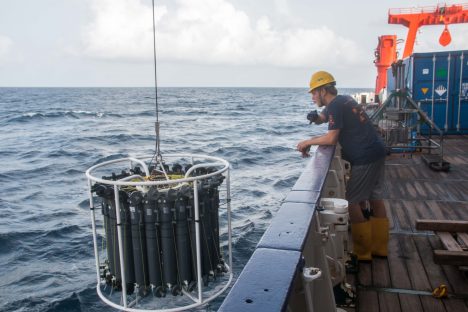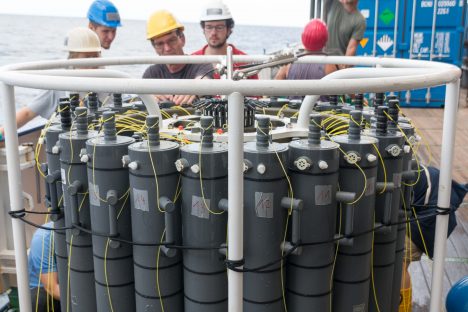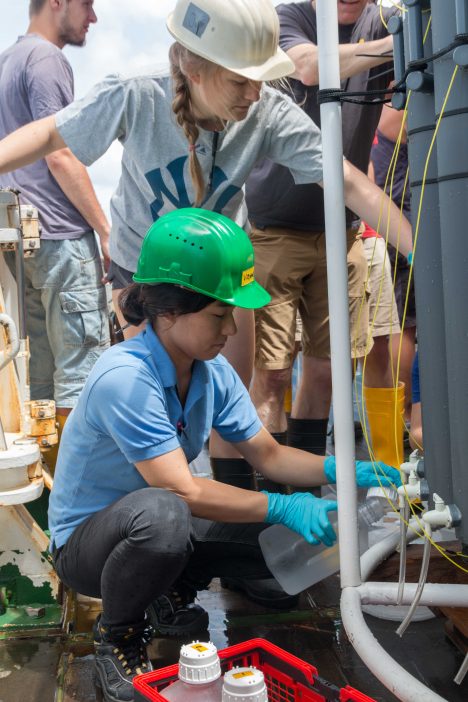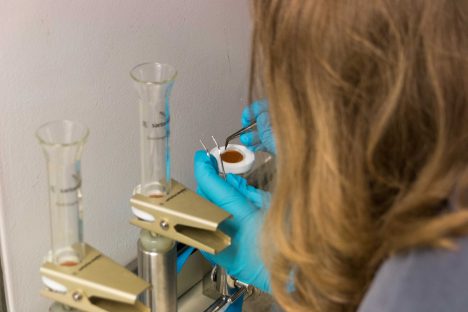Dear interested reader, colleagues, friends and families,
as mentioned in our last blog, we took water samples across 4000 m depth using the CTD (conductivity, temperature, depth) – rosette sampler at our first station in the Caribbean Sea. Here, we are interested in the distribution of viruses, bacteria and protists (unicellular organisms) in the depth. The CTD system exhibits a set of sensors to derive physical parameters like the density of water, the oxygen content and salt concentrations in real time during the run down to the ground. These parameters are very helpful for us, as we choose the water depths for the sampling according to the profile of the different parameters.
The chlorophyll-a-maximum was reached in 60 m depth that is a zone with high density of photosynthetically active organisms (mainly algae). Chlorophyll a is the major pigment of algae to make use of the light energy and to produce sugars and other substances. We expect the highest numbers of living organisms in this water layer. After measuring the different parameters on the CTD’s way down, the water samples of the respective water layers were collected by the CTD on its way up. The results show that the temperature of 28 °C at the water surface decreases to 4 °C between 1000 and 1500 m depth and remains constant in the deep sea. In this depth and below, the cold water stores the most oxygen and has a salinity of 3.5 % (which means 35 g salt per litre). The density values do not change across depth, which indicates a relatively homogenous water body in the deep sea of the Caribbean Sea.
The CTD system was ready to be activated during the run (Image 1, CTD tubes open). After boarding of the CTD on the RV Meteor (Image 2, CTD tubes closed), our scientists took the water samples of different depths for diverse purposes (Image 3). For example, some water samples were mixed with iron chloride and filtered to obtain virus particles in the brownish-red precipitate on the filter (Image 4). The material will be subjected to modern DNA sequencing methods in Cologne to study virus diversity in the deep sea.
Your M139 team
–
Liebe interessierte Leser, Kollegen, Freunde und liebe Familien,
wie bereits im letzten Blog erwähnt, nahmen wir mithilfe des CTD-Kranzwasserschöpfers Wasserproben über das 4000 m tiefe Vertikalprofil unserer ersten Beprobungsstation in der Karibik. Wir interessieren uns hier für die Verteilung von Viren, Bakterien und Protisten (Einzeller) in der Tiefe. Das CTD-System bietet viele Sensoren, mit denen physikalische Parameter wie die Dichte, Sauerstoff– und Salzkonzentrationen in Echtzeit während des Einsatzes ermittelt werden können. Diese Parameter sind sehr hilfreich, da wir die exakten Tiefen für die Probenahmen gemäß dieser Werte auswählen.
Das Chlorophyll a – Maximum wurde bei etwa 60 m Tiefe erreicht. Dies ist eine Zone mit hoher Dichte an photosynthetisch aktiven Organismen (vor allem Algen). Die Algen benutzen das Pigment Chlorophyll um Lichtenergie zu binden und Zucker und andere energiereiche Substanzen aus Kohlendioxid zu bilden. In der Tiefe des Chlorophyllmaximums erwarten wir auch die größten Anzahlen an lebenden Organismen. Nachdem die verschiedenen Parameter beim Abtauchen des CTD-Systems gemessen wurden, wird das auftauchende CTD-System für Probenahmen in den spezifischen Wasserschichten aktiviert. Die Auswertung der Ergebnisse ergab eine Temperatur von 28 °C an der Wasseroberfläche, die bis auf 4 °C zwischen 1000 und 1500 m Tiefe abfällt und bis in die Tiefsee konstant bleibt. In dieser Tiefe und darunter speichert das kalte Wasser den meisten Sauerstoff und weist einen Salzgehalt von 3.5 % (das entspricht 35 g Salz pro Liter) auf. Die Dichtewerte über das gesamte Tiefenprofil ändern sich nicht, was auf einen homogenen Wasserkörper in der Tiefsee der Karibik hinweist.
Das CTD-System wurde für den Einsatz aktiviert (Bild 1, CTD-Röhren geöffnet). Nachdem das CTD-System geborgen wurde (Bild 2, CTD-Röhren geschlossen), nahmen unsere Wissenschaftler Wasserproben aus verschiedenen Tiefen für diverse Zwecke (Bild 3). Beispielsweise wurden manche Wasserproben mit Eisenchlorid versetzt und gefiltert, um die Viruspartikel aus dem rotbraunen Niederschlag am Filter zu erhalten (Bild 4). Das gewonnene Material wird später durch Hochdurchsatz-Sequenzierung von DNA in Köln analysiert, um die Virus-Diversität in der Tiefsee zu erforschen.
Ihr M139-Team

Image 1 | The CTD system on its way down to the deep sea. (Photo: Johannes Werner)

Image 2 | The CTD system on board again. The tubes were closed on the way up in selected depths. (Photo: Johannes Werner)

Image 3 | The scientists take the water samples out of the tubes and use them for different purposes. (Photo: Johannes Werner)

Image 4 | The enormous amounts of water samples of different depths are filtered that takes many hours. This time, red-brownish iron chloride is added to the samples in order to catch all virus particles. (Photo: Johannes Werner)
Großartig😀